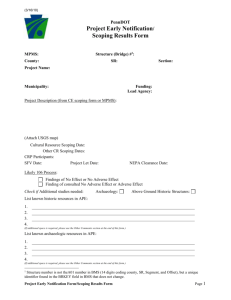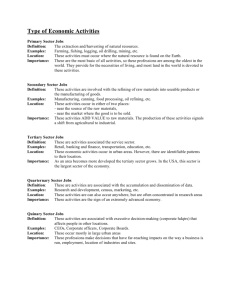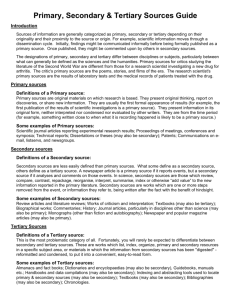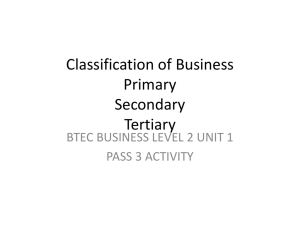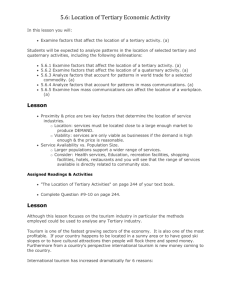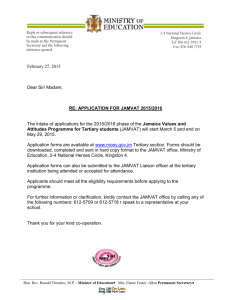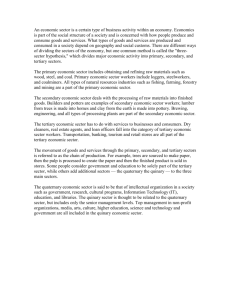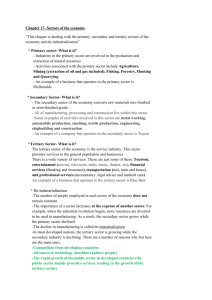Better Business Cases: Scoping Document
advertisement
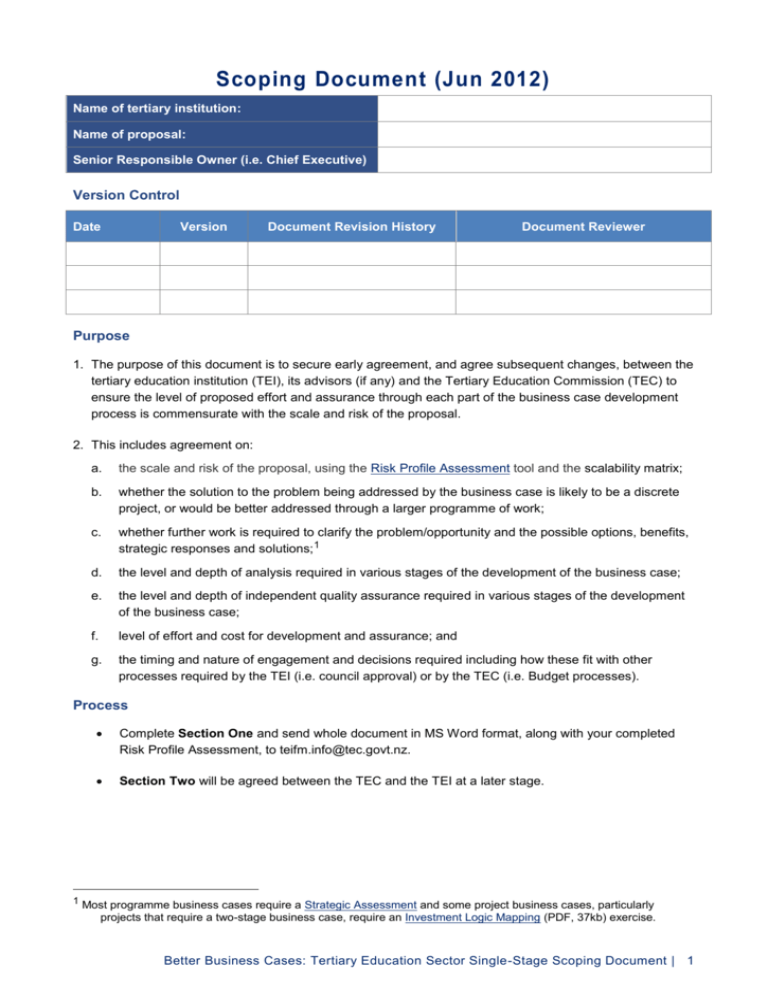
Scoping Document (Jun 2012) Name of tertiary institution: Name of proposal: Senior Responsible Owner (i.e. Chief Executive) Version Control Date Version Document Revision History Document Reviewer Purpose 1. The purpose of this document is to secure early agreement, and agree subsequent changes, between the tertiary education institution (TEI), its advisors (if any) and the Tertiary Education Commission (TEC) to ensure the level of proposed effort and assurance through each part of the business case development process is commensurate with the scale and risk of the proposal. 2. This includes agreement on: a. the scale and risk of the proposal, using the Risk Profile Assessment tool and the scalability matrix; b. whether the solution to the problem being addressed by the business case is likely to be a discrete project, or would be better addressed through a larger programme of work; c. whether further work is required to clarify the problem/opportunity and the possible options, benefits, strategic responses and solutions; 1 d. the level and depth of analysis required in various stages of the development of the business case; e. the level and depth of independent quality assurance required in various stages of the development of the business case; f. level of effort and cost for development and assurance; and g. the timing and nature of engagement and decisions required including how these fit with other processes required by the TEI (i.e. council approval) or by the TEC (i.e. Budget processes). Process Complete Section One and send whole document in MS Word format, along with your completed Risk Profile Assessment, to teifm.info@tec.govt.nz. Section Two will be agreed between the TEC and the TEI at a later stage. 1 Most programme business cases require a Strategic Assessment and some project business cases, particularly projects that require a two-stage business case, require an Investment Logic Mapping (PDF, 37kb) exercise. Better Business Cases: Tertiary Education Sector Single-Stage Scoping Document | 1 Business Case Scoping Document Section One – TEI to complete Summarise the nature of the problem/opportunity the proposal is seeking to address and possible solutions (use the headings below as a guide) Problem Describe the problem that needs to be addressed (both the cause and effect). What evidence is there to confirm the cause and effect of the problem? Does the problem need to be addressed at this time? Benefits Describe the expected benefits from fixing the problem. Provide some possible key performance indicators that will be used to provide evidence that the benefits have been delivered. Why are the benefits so important to the institution? Possible Strategic Responses Summarise a range of possible strategic responses to the problem and the rationale for their inclusion. Why are the proposed strategic responses the most effective possible responses to the problem? Are the proposed strategic responses feasible? Possible Solutions Summarise a range of projects (i.e. solutions) which are consistent with the strategic responses listed above. Why are the proposed solutions the best way to respond to the problem and deliver the expected benefits? Can the solutions be delivered (i.e. costs, risks, timeframes, governance etc)? Section Two (to be completed jointly by TEI and TEC after sending Section One to the TEC) Scale and risk Scalability matrix category agreed in terms of risk2 and scale3? Low risk – Low risk – High risk – High risk – large small scale large scale small scale scale Programme or project? Investment Logic Mapping required? Yes or No Proposed level and effort of analysis (depending on the scale and risk)for business case development Type of business case Single-Stage – Single-Stage – light full Two-stage Other (please indicate) 2 This is informed by a SSC Gateway Risk Profile Assessment self assessment, available at http://www.ssc.govt.nz/gateway-rpa-agency-responsibilities . 3 The scale should be expressed as an estimated range of whole of life costs (WOLC) as defined in Cabinet Office circular CO(10)2 Capital Asset Management: Expectations, available from the Cabinet Office web-site at http://www.dpmc.govt.nz/cabinet/index.htm Better Business Cases: Tertiary Education Sector Single-Stage Scoping Document | 2 Proposed scope of analysis, to support the evidence required against the Key Review Criteria (see Appendix A for example for a single-stage business case)? Proposed methodological approach to options analysis? (full, moderate or light as per Appendix B) Agreed amount of effort and cost for business case development Proposed level and effort of business case assurance and assessment Level of Quality Assurance Agreed level: Gateway Review, for high risk projects Yes or No How will the TEI and the TEC engage during the development process? Include a proposed timetable with key milestone dates. Agreed amount of effort and cost for business case assurance and assessment Decision maker Who will make the decision? When will the decision be made? Fit with budget/funding process? Better Business Cases: Tertiary Education Sector Single-Stage Scoping Document | 3 Appendix A: High-Level Assessment Criteria (single -stage) SINGLE STAGE BUSINESS CASE Examples of main evidence required Comments Key review criteria by case4 Strategic Case 1. Is the proposed project an integral part of the institution’s business strategy? 2. Is the proposed investment Extracts from business and other relevant strategies Reference to relevant government (i.e. Tertiary Education Strategy) and organisational policies Relevant extracts from business and other strategies sufficiently large and stand alone to form a project or could it be Reference to scoping documentation SMART spending objectives - specific - measurable - achievable - relevant - timely Evidence of stakeholder and customer involvement and support Clear statement of business outcomes and service outputs Statement of any security and confidentiality issues more sensibly undertaken as part of another programme or project? 3. Are the investment objectives and underpinning business needs defined clearly and supported by the key stakeholders and customers? 4. Is the scope for potential change to current services and business processes clearly defined? 5. Have the main benefits been clearly defined by key stakeholders and customers, alongside arrangements for their realisation? 6. Have the main risks been identified, alongside arrangements for their management and control? 7. Have the key organisational constraints and business dependencies been identified? Outline of benefits realisation plan Direct and indirect to the organisation and wider public sector Cash ($) and non-cashreleasing Ranking of benefits by key stakeholder Outline of risk management strategy Business risks Service risks Likely probabilities and impact (high, medium, low) Evidence of critical path Related programmes and projects Assessment of internal and external constraints Economic Case 8. Have the critical success factors (CSFs) for options appraisal been identified? 4 Prioritised CSFs (high, medium, low) Relevant performance measures Source: HM Treasury business case guidance (UK) Better Business Cases: Tertiary Education Sector Single-Stage Scoping Document | 4 9. Has a sufficiently wide range of options been identified and assessed within the long -list? 10. Has a preferred way forward been identified following robust analysis of the available options? 11. Does the preferred option represent best value for money or the most economically advantageous offer? Use of any feasibility study 10 to 12 main options – full description Use of the options framework - for business scope - for potential solutions - for service delivery - for implementation - for funding. SWOT analysis of options against: - spending objectives - critical success factors - benefits criteria - evidence of likely support from key stakeholders Rigorous use of investment appraisal tools and techniques All assumptions recorded Achievable benefits streams Stakeholders and customers support Commercial Case 12. Has the procurement strategy for Consideration of procurement options Potential for innovation within the provision of services and solutions Potential for risk transfer Potential for new business and alternative revenue streams Likely contract length Consideration of - core, desirable and optional services - delivery time-scales (phased improvements etc.) - potential payment mechanisms - ownership of residual assets - service levels and performance measures Change management plans Proposed mechanisms and milestones Assessment of personnel implications Market research and surveys Use of standard contractual terms and conditions Benchmarks – similar projects the successful delivery of the required services been considered and prepared in sufficient detail? 13. Is there sufficient scope for a potential deal, which will meet organisational needs whilst offering best value for money? 14. Has the potential deal been considered in sufficient detail? The how rather than what. 15. Is there a clear understanding of the business change agenda? 16. Is the potential deal still likely to be acceptable and bankable within the private sector? Financial Case Better Business Cases: Tertiary Education Sector Single-Stage Scoping Document | 5 17. Is the solution still likely to be Financial appraisals for preferred option, including full assessment: - capital and current requirements - net effective on prices - balance sheet impact - income and expenditure account - stakeholder and customers agreement Programme Methodology (e.g. MSP) Project methodology (e.g. PRINCE2) - project board/committee and structure - project manager and team - project plan - project resources and budget - reporting mechanisms Use of external advisers - legal - financial - other Outline arrangements for: - benefits study and realisation plan - risk management strategy and plan - change management strategy and plan - contract management Arrangements for evaluation: - peer reviews - gateway reviews (if required) - project implementation reviews - post-evaluation reviews Contingency plans affordable? Management Case 18. Are all the necessary arrangements in place for the successful completion of the next phase? Better Business Cases: Tertiary Education Sector Single-Stage Scoping Document | 6 Appendix B: Proposed methodological approach to options analysis (full/moderate/light) Standard Full cost-benefit analysis (CBA)/multi-criteria analysis (MCA) Moderate cost-benefit analysis (CBA)/multicriteria analysis (MCA) Light cost-benefit analysis (CBA)/multicriteria analysis (MCA) Model National Economy CBA Financial Analysis (CBA Primer – see Treasury website) Financial Analysis (CBA Primer – see Treasury website) Scope National economy Institution and selected sectors (i.e. health, local economy etc) Institution only All resource flows, including non-monetary costs and benefits All resource flows that can be expressed in monetary terms. All resource flows that can be expressed in monetary terms. Non-monetary benefits and costs MCA of intangibles MCA of intangibles Ranking of intangibles (if any) Uncertainty Quantitative risk analysis Sensitivity testing of key drivers Sensitivity testing of key drivers Better Business Cases: Tertiary Education Sector Single-Stage Scoping Document | 7

